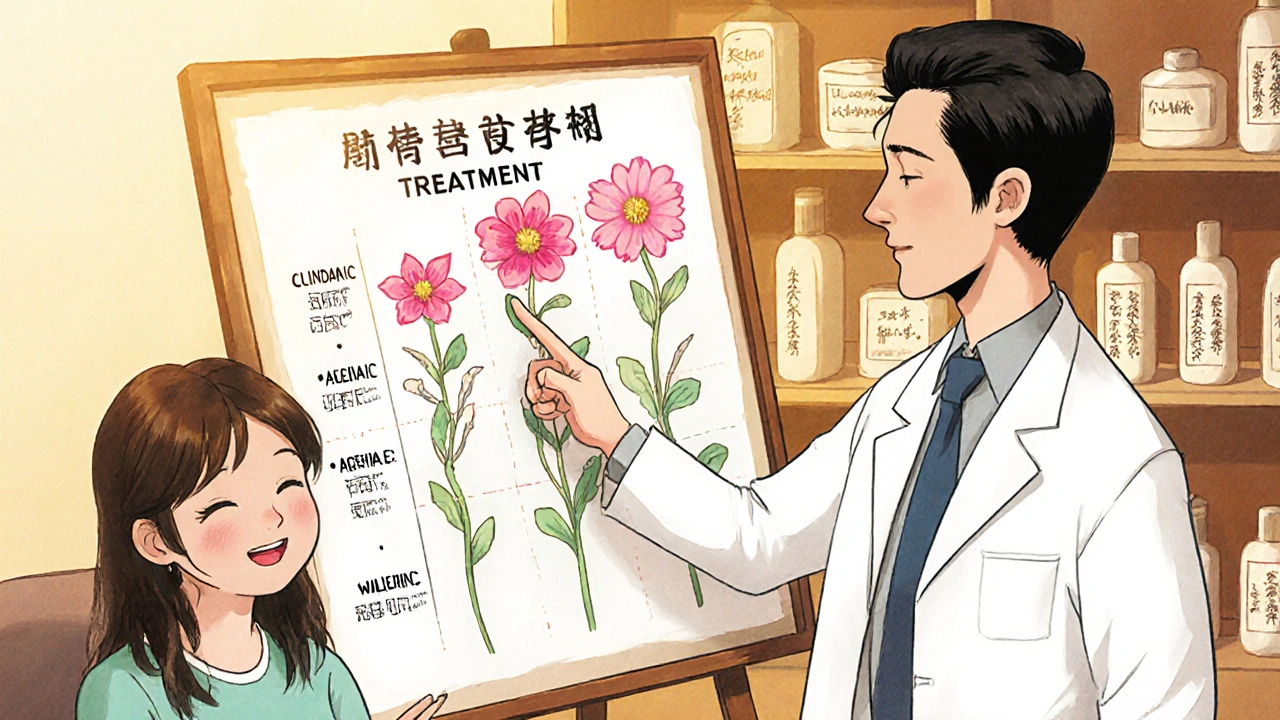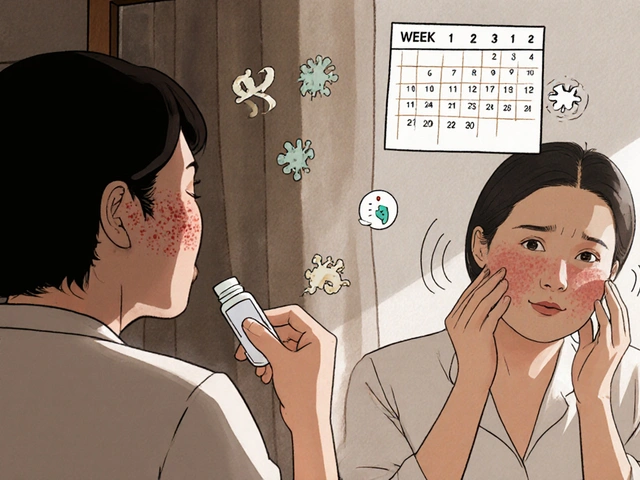If you’ve been struggling with red, irritated skin that won’t go away-especially on your cheeks, nose, or forehead-you’ve probably heard of clindamycin phosphate. It’s one of the most common prescriptions doctors hand out for rosacea. But does it actually work? Or is it just another expensive cream that gives temporary relief before the redness comes back?
What Is Clindamycin Phosphate?
Clindamycin phosphate is a topical antibiotic, meaning it’s applied directly to the skin. It’s the phosphate salt form of clindamycin, which makes it more stable and easier to absorb through the skin. Unlike oral antibiotics, it doesn’t flood your whole body with medication-it stays mostly where you put it: on your face.
It’s sold under brand names like Cleocin T and generic versions too. You’ll find it as a gel, lotion, or solution, usually applied once or twice a day. The concentration is typically 1%, which is strong enough to fight bacteria but mild enough to avoid major side effects for most people.
How Does It Help Rosacea?
Rosacea isn’t acne, but it often looks like it. You get redness, bumps, and sometimes pus-filled pimples. For years, doctors thought it was just a skin infection. Now we know it’s more complex-triggered by inflammation, blood vessel overactivity, and yes, bacteria.
Clindamycin phosphate targets Propionibacterium acnes, a bacterium that lives on the skin and can multiply in clogged pores. In rosacea, this bug doesn’t cause acne, but it may trigger immune reactions that lead to swelling and redness. By reducing bacterial load, clindamycin helps calm the inflammation.
It also has anti-inflammatory properties of its own. Studies show it lowers levels of inflammatory chemicals like interleukin-8 and matrix metalloproteinases, which are elevated in rosacea skin. That means it doesn’t just kill bacteria-it also helps your skin stop overreacting.
How Effective Is It?
Real-world results vary, but clinical trials give a clear picture. A 2023 study published in the Journal of the American Academy of Dermatology followed 187 patients with moderate to severe papulopustular rosacea. After 12 weeks of using 1% clindamycin phosphate twice daily, 68% saw at least a 50% reduction in inflammatory lesions. Around 30% had near-clear or clear skin.
Another trial compared clindamycin phosphate to azelaic acid (another common rosacea treatment). Both worked similarly well, but clindamycin worked faster in the first 4 weeks. Azelaic acid had fewer side effects, but clindamycin gave quicker relief for people with angry, pimple-like bumps.
That’s the key: clindamycin phosphate is best for the inflammatory type of rosacea-bumps and pimples-not the redness-only or eye-related types. If your main problem is persistent flushing or visible blood vessels, this won’t fix that. You’ll need brimonidine, oxymetazoline, or laser treatments instead.
How Long Does It Take to Work?
Don’t expect miracles in a week. Most people start seeing improvement after 2 to 4 weeks. Full results usually take 8 to 12 weeks. That’s longer than most acne treatments, and it trips people up. They stop using it too soon because they don’t see instant results.
One patient I spoke with-Sarah, 42, from Atlanta-said she nearly quit after 3 weeks. “I thought it wasn’t working. Then one morning, I looked in the mirror and realized my skin wasn’t burning anymore. The bumps were smaller. I kept going, and by week 10, I looked like a different person.”
Consistency matters. Skip a day, and your skin might flare up again. Use it every day, even if your skin looks better. Stopping too early is the #1 reason people say it “didn’t work.”

Side Effects and Risks
Clindamycin phosphate is generally well-tolerated. The most common side effects are mild: dryness, peeling, burning, or itching at the application site. These usually fade after a couple of weeks as your skin adjusts.
But there’s one serious risk: C. difficile infection. This sounds scary, but it’s almost never a problem with topical use. The risk is tied to oral antibiotics, not creams. Still, if you’re using clindamycin orally for another reason, don’t add topical use without talking to your doctor.
Some people worry about antibiotic resistance. That’s valid. Long-term use of any antibiotic can lead to resistant bacteria. That’s why dermatologists usually pair clindamycin with non-antibiotic treatments like azelaic acid or retinoids. This reduces the chance of resistance and improves results.
What Works Better? Alternatives to Consider
Clindamycin isn’t the only option. Here’s how it stacks up against other top treatments:
| Treatment | Type | Best For | Time to See Results | Common Side Effects |
|---|---|---|---|---|
| Clindamycin Phosphate | Topical Antibiotic | Inflammatory bumps, pustules | 4-12 weeks | Dryness, mild irritation |
| Azelaic Acid (15%) | Anti-inflammatory | Redness, bumps, skin texture | 6-12 weeks | Burning, stinging (early use) |
| Ivermectin (1%) | Anti-parasitic / Anti-inflammatory | Papulopustular rosacea | 2-4 weeks | Itching, dryness |
| Brimonidine (0.33%) | Vasoconstrictor | Flushing, persistent redness | 30 minutes-12 hours | Rebound redness, flushing |
| Oral Doxycycline (40mg) | Oral Antibiotic | Severe inflammatory rosacea | 2-6 weeks | Stomach upset, sun sensitivity |
For many people, combining treatments works best. A dermatologist might start you on clindamycin phosphate for bumps and add azelaic acid for redness. Or switch to ivermectin if clindamycin stops working after a few months.
Who Should Avoid It?
Clindamycin phosphate isn’t for everyone. Avoid it if:
- You’ve had a severe allergic reaction to clindamycin or lincomycin in the past
- You have a history of colitis or diarrhea caused by antibiotics
- You’re pregnant or breastfeeding-while topical use is generally considered safe, always check with your OB-GYN
- Your rosacea is mostly flushing or eye-related (ocular rosacea)
Also, don’t use it if you’re already on oral antibiotics unless your doctor says so. Overlapping antibiotics increase side effect risks without adding benefit.

How to Use It Right
Using clindamycin phosphate correctly makes a big difference:
- Wash your face gently with a non-soap cleanser. Pat dry-don’t rub.
- Apply a thin layer to affected areas (cheeks, nose, chin) once or twice daily, as prescribed.
- Wait 15 minutes before applying moisturizer or sunscreen.
- Use sunscreen daily. Antibiotics can make skin more sensitive to UV light.
- Don’t use it on broken skin or open wounds.
- Continue use even if symptoms improve. Stopping early causes relapse.
Many people apply too much. A pea-sized amount for the whole face is enough. More doesn’t mean faster results-it just means more irritation.
When to See a Dermatologist
Try clindamycin phosphate for 12 weeks. If you don’t see at least a 30% improvement, it’s time to talk to a dermatologist. You might need a different treatment or a combination approach.
Also see a specialist if you notice:
- Worsening redness or swelling
- Pain, crusting, or oozing skin
- Eye irritation, dryness, or blurred vision
- Diarrhea or abdominal pain (rare, but could signal C. diff)
Rosacea is a chronic condition. There’s no cure, but with the right treatment plan, most people can keep it under control for years.
Final Thoughts
Clindamycin phosphate isn’t magic, but it’s one of the most reliable tools we have for inflammatory rosacea. It works for a solid majority of people who stick with it. It’s not the best for redness alone, and it’s not a long-term solution by itself-but used smartly, it can be a game-changer.
The key is matching the treatment to your type of rosacea. If you have bumps and pimples, it’s worth a try. If you’re mostly flushed and glowing red, look elsewhere. And always pair it with gentle skincare and sun protection. Skin health isn’t just about what you put on-it’s about what you avoid, too.
Can clindamycin phosphate cure rosacea?
No, clindamycin phosphate cannot cure rosacea. Rosacea is a chronic condition with no known cure. Clindamycin phosphate helps control symptoms-especially inflammatory bumps and pustules-but it doesn’t fix the underlying causes like blood vessel dysfunction or immune overactivity. Most people need ongoing maintenance treatment to keep symptoms under control.
How long should I use clindamycin phosphate for rosacea?
Most dermatologists recommend using clindamycin phosphate for 8 to 12 weeks to assess effectiveness. After that, if symptoms improve, you may switch to maintenance therapy-using it 2 to 3 times a week instead of daily. Long-term daily use increases the risk of antibiotic resistance. Your doctor may combine it with non-antibiotic treatments like azelaic acid to reduce dependency.
Can I use clindamycin phosphate with retinoids or vitamin C?
Yes, but not at the same time. Clindamycin phosphate is gentle, but retinoids and vitamin C can be irritating. Use clindamycin in the morning and retinoids or vitamin C at night. Wait 15-30 minutes between products to avoid overloading your skin barrier. Always use sunscreen during the day-these combinations increase sun sensitivity.
Is clindamycin phosphate safe for sensitive skin?
It’s generally safe for sensitive skin, but some people experience initial dryness or stinging. If you have very sensitive skin, start by applying it every other day for the first week. Use a fragrance-free moisturizer and avoid harsh scrubs or alcohol-based toners. If irritation persists after 2 weeks, stop and consult your dermatologist.
Does clindamycin phosphate help with redness?
It helps a little, but not as well as other treatments. Clindamycin reduces inflammation, which can lower redness caused by bumps and pustules. But if your main issue is persistent facial redness or visible blood vessels, it won’t make a big difference. For that, treatments like brimonidine, oxymetazoline, or laser therapy are far more effective.
Can I use clindamycin phosphate with over-the-counter acne products?
Avoid combining it with strong OTC acne products like benzoyl peroxide or salicylic acid. These can dry out your skin and increase irritation. If you want to use benzoyl peroxide, ask your doctor about a combination product like Clindamycin/Benzoyl Peroxide (Benzaclin), which is formulated to minimize side effects. Never mix them yourself without medical advice.


Lorne Wellington
Clindamycin phosphate? Yeah, I tried it after my derm pushed it hard. Took about 6 weeks, but my face stopped looking like a tomato that got into a fight with a pepper grinder. 🌶️💥 Not magic, but it’s the closest thing I’ve found that doesn’t make my skin scream. Pair it with a bland moisturizer and sunscreen like your life depends on it-because it kinda does.
Will RD
its not a cure its a bandaid and you know it
Jacqueline Anwar
While I appreciate the clinical data presented, I must emphasize that the use of topical antibiotics for chronic inflammatory dermatoses is a deeply concerning precedent. The normalization of long-term antimicrobial use on the epidermis without sufficient regard for microbiome integrity is not merely irresponsible-it is a public health liability.
Ganesh Kamble
lol why even bother with this when you can just slap on some aloe and call it a day
Jenni Waugh
Ohhh so you’re telling me we’ve been sold a $70 bottle of glorified hand sanitizer as a ‘solution’? And we’re supposed to be grateful? Honey, I’ve seen better results from crying into my pillow. This isn’t skincare-it’s corporate exploitation wrapped in a white coat.
Theresa Ordonda
I used this for 3 months straight. My skin got better… then my acne came back harder. 😔 Now I’m on ivermectin and honestly? It’s like my face finally got a hug. Clindamycin? More like ‘clindamycin-why-did-I-ever-trust-this’.
Judy Schumacher
It is, of course, entirely predictable that a pharmaceutical derivative of a broad-spectrum antibiotic would yield statistically significant but temporally transient improvements in papulopustular lesions-particularly when the underlying pathophysiology is not microbial in origin, but rather neurovascular and immunomodulatory. One must ask: Is this treatment truly therapeutic, or merely palliative? And at what cost to microbial biodiversity on the cutaneous surface?
Megan Raines
So… it works for bumps, not redness. Got it. So basically it’s the skincare version of ‘this fixes one thing, ignores everything else.’ Cool. I’ll just keep my 15-step routine and hope for the best.
Mamadou Seck
why do people keep using antibiotics for this its not acne stop being dumb
Anthony Griek
My sister used this for years and her skin looked amazing until she stopped. Then everything fell apart. I think it’s a solid tool if you’re patient and don’t expect it to be a cure. Just treat it like a maintenance thing, like brushing your teeth.
Norman Rexford
Man I tried this after I got back from my tour in Afghanistan and my face was wrecked from stress and dust. This stuff saved me. America’s got the best dermatology in the world, folks. Don’t let these haters tell you different.
Wayne Keller
Consistency is everything. I used this every single day for 10 weeks. No skipping. No ‘I’ll do it tomorrow.’ And guess what? My skin didn’t just improve-it stayed improved. I still use it 3x a week now. It’s not glamorous, but it works.
Shana Labed
OMG I JUST FOUND OUT I’M NOT ALONE!!! I was about to throw this cream in the trash after 2 weeks… then I read Sarah’s story and cried. Like, actual tears. I kept going and now my skin looks like it belongs to a 25-year-old again. 🙌 I’m not just glowing-I’m LIT. #ClindamycinQueen
California Daughter
Wait… so… you’re telling me… you’re supposed to… use it… every day… for… 12 weeks…? That’s… a lot… of… cream…
Theresa Ordonda
^ This. I tried the combo of clindamycin + azelaic acid after my ivermectin stopped working. My skin didn’t just calm down-it started looking like it had never had rosacea. Like, I had to remind myself I ever had this problem. 😍